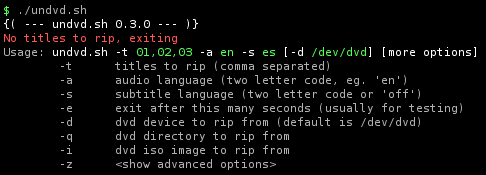When you decide to code an application in a problem space that already has a rich bouquet of solutions the typical questions come to mind immediately. What is this going to accomplish? Why not just use an existing application? Why reinvent the wheel? Perfectly valid concerns, and yet every application has some reason to be, or it wouldn't exist in the first place. Sometimes it's a question of timing - better solutions did not exist at inception. Sometimes it's about quality: that one over there works but doesn't do it well enough. And sometimes it's something different altogether. That one does too much and I don't understand it.
There are people out there who are proper movie buffs. People who can quote lines out of a movie and identify passages to extreme detail. I've known a bunch of people like that, but I've never been like that myself. To me watching movies was never a really important thing, it was kind of a second tier interest. But knowing people like this has its advantages, you can borrow their movies. :cool: I remember how we used to lug around VHS tapes at school.
So my lack of outright passion about movies is really the reason why I never took after the dvd ripping crowd. When DVDs were fairly new, people were so excited about divx. My friends at school used to discuss bitrates and filesizes. I didn't follow any of that, I wasn't really interested. I didn't have a DVD drive, nor did I think paying €38 for a movie was such a good deal.
But admittedly, ripping the occasional movie is useful. DVDs in general are just a hassle and I don't like to put up with them. Back in those days (a few years later, when I had bought my first dvd drive for my first custom built computer) I would try it a few times. I didn't mirror the excitement of my friends. It took a really long time to rip a movie, and the result wasn't that good. I don't know what I was doing wrong. We used the Gordian Knot suite and followed the guides on Doom9. But while the program gave me every possibility to tweak the settings, I didn't know what they mean, I didn't *want* to know what they mean, I just wanted to rip it and move on.
And that is precisely the point where undvd comes in. I've tried a bunch of tools for ripping DVDs. dvd::rip might be the most merited linux tool. There's also acidrip and a bunch of others I don't even remember anymore. All these tools had the same two flaws:
- They present a lot of options that I don't know anything about, and I don't care about. And presumably, since my results were never very good, these are crucial for good results.
- It takes anything from 15 to 45 minutes to actually set up all the options, inputs, outputs, filters, cropping, the whole shebang. When something fails, like the disc can't be read from, the tool sometimes crashes. If it does, all your set-up work is lost. But even if you have a working setup from before and you want to rip another movie you still have to double check all these settings, because ripping takes a long time and if you mis set something by accident you may only discover it far along the way.
Therefore, I think it's fair to say that we have the Photoshop of DVD ripping in place. Personally I want to use Paint for this activity, because I have no deep interest in all the details.
Making it work
So if there is something complicated you have to do again and again, and every time you worry that you'll get it wrong and even if you get it right next time you probably don't remember what you did again. Faced with that, what do you do? In the middle ages monks would copy books by hand, at extraordinary effort. Not only would they transcribe the text, they would also copy and enhance the illustrations so that the copy, while not being the original, would be no less worthy. This was their calling, transcribing was an art form. Then came Gutenberg. Now granted, building a printing press took a lot more effort than transcribing a book. But once you had done that, copying books was a no brainer.
To me ripping a DVD is not an art form, it's a chore. And if I can figure out how to do it once and never have to worry about it again, then it's well worth the effort. So I set out to figure it out, I looked up the details and read the fine print. Eventually I had a fairly good idea of how to do it, and the results were coming along.
undvd became the wrapper around that nastiness I didn't want to look at or remember. And for my money it worked well. It also encompasses certain design decisions that were important to me.
Why no gui?
The Photoshop rippers all come with a gui interface. That's hardly a surprise, the plethora of settings they allow you to fiddle with would look like mplayer's list of options if they weren't gui apps. It's practically impossible *not* to have a gui for those guys.
But DVD ripping is not inherently a gui centric activity. You need the gui to write your missile launch plan, but once you start ripping the gui doesn't serve any purpose anymore. It just sits there in memory, and you could just as well remove it while ripping and then bring it back once it's over. So 95% of the time the gui isn't being used.
Apart from the simple fact that coding a gui is a lot more work, I consider a gui a hindrance in this case. There is nothing a gui would do for undvd that would improve how the program is being used.
Why not interactive?
There are some non-gui rippers/encoders out there, like h264enc and ripdvd (and probably a bunch of others). Common to them is that they run interactively. They ask you a series of questions to determine everything they need to know about ripping the DVD before they can start doing the work.
Unfortunately, interactive mode suffers from the same problems that a gui interface does. You have to answer all the questions whether you know what to answer or you don't. And more importantly, it's hard to reproduce the result, because you don't remember what you answered the last time.
And crucially, an interactive program won't let you just run it and go do something else, you have to stick around to do your part before the app will do its part. With a ripper this isn't such a big deal, because all the interaction happens at the beginning, but it's still something I like to do without.
Why bash?
The standard way of building a ripper is to wrap an interface around the scary mencoder command line interface. Whether this is a gui or not has no impact on how the ripper interacts with mencoder. There is no programmatic interface to mencoder, so you're stuck running it from a shell one way or the other.
Taking this into account, a bash script is pretty much the easiest way to handle shell commands. (If you're a perl nut, perhaps that would suit you better, but I'm not.) I've tried running commands from python (and using it to capture the exit code, stdout, stderr etc), and it's far easier just to use plain bash.
As a self imposed restriction, it will also keep the program from becoming too big. Bash is not exactly the greatest abstraction language and takes quite a bit of discipline to keep it from getting totally convoluted, which is why I would not use it for anything bigger than a simple application.
Feature creep
Unfortunately, every program that evolves will face the issue of new features. Personally I think undvd does what it does well enough, I'm satisfied. But any one-size-fits-all strategy is bound to be somewhat constrained. The question is where to stop?
Two things came up that weren't intended for undvd:
Scaling
To start off with the first issue, undvd makes the assumption that the output video will be smaller than the original. This is fairly sensible, given that most rips are done this way, and considering that 6x compression does demand a lot from your encoder unless you compromise a bit on dimensions. Crucially, even if you watch a movie full screen the software/hardware scaling does a good enough job of stretching the image without clobbering it. Having said that, undvd's decision to scale to 2/3 of the original size is arbitrary and I accept that it's not a well justified constraint.
So scaling will be added.
Bitrate and 2-pass encoding
The bitrate issue, on the other hand, is hairy. Very hairy. I kept thinking about a meaningful way to set the bitrate. The obvious thing is to make it an integer parameter, like say 1000kbps. But what is that? It's just a number, a meaningless number. The "right" bitrate differs from movie to movie, from codec to codec, perhaps even from encoder to encoder. We are back in Photoshop land.
So I follow the convention of setting a file output size instead. If you say you want this title ripped to a file of 700mb, the bitrate is calculated automatically. This method is flawed, however, because the size we can accommodate for the video depends on how much space the audio requires, and there's no way to know this exactly. (Currently the mean audio bitrate is presumed 160kbps.) So the output size tends to come within 10% of the user-specified size.
The thing is, if you start messing with the bitrate you should also consider 2-pass encoding, because you can mess up your video quite badly that way. undvd tries to do "the right thing" by picking 2-pass encoding if the calculated bitrate is below the default. But you can always override to 1-pass or 2-pass whatever the case is.
In any event, if you don't use these new options then undvd does exactly what it always has.
And now for some screenshots



 December 17th, 2007
December 17th, 2007



 Lesson #1: Crappy tv commercials never go away
Lesson #1: Crappy tv commercials never go away